Kristine Hughes's Blog, page 142
August 5, 2011
The History of Grey's Court by Jo Manning
GREYS COURT, AN UNUSUALLY BEAUTIFUL NATIONAL TRUST SITE NEAR HENLEY-UPON-THAMES
[image error]
On my latest visit to London this past spring, my daughter suggested that we go to Grey's Court, a National Trust house she'd been curious about but had never visited. The original buildings on the site dated from before the 12th-century and there was a famous garden; it was in the foothills of the Chilterns, outside of Henley-on-Thames (where I'd never been) and we could explore that town as well. We'd picnic on the extensive grassy grounds overlooking the house and have tea later in the Tea Room located in the Cromwellian Stables.
(Yes, I know, looking at the photo above – that is certainly not a medieval building! – but the rest of the surrounding buildings – erected over at least 600 years -- are decidedly from the early medieval period and these very well evoke for the visitor those days of yore.)
This site is mentioned in the 11th century Domesday Book as Redrefield (Rotherfield). The owners were the de Grey family, barons who fought with their kings at Crecy, Bosworth, in the Scottish wars, and in the Hundred Years War with France. The most famous of the de Greys was John de Grey, a professional soldier who became one of the original Knights of the Garter. After the Battle of Crecy 1346 he was given a license to crenellate Rotherfield, i.e., fortifying it by providing the walls with battlements.
Upon the death of his grand-daughter, Alice, in 1455, the lands passed to the crown. Henry VII awarded it first to his uncle, Jasper Tudor, then, in 1514, Robert Knollys received the property "for the annual rent of a Red Rose at Midsummer". Robert Knollys' son, Francis Knollys, a good friend of King Henry VIII, became the next owner of these lands. (His wife was first cousin to Queen Elizabeth I through her mother's family, the Boleyns.)
[image error]
A view from the Knot Garden up to the Great Tower
Francis Knollys was a firm and committed Protestant and a lifelong confidante to his queen. He was treasurer of the royal household for almost 25 years and also oversaw Mary, Queen of Scots, in her captivity. He died in 1596.The tombs of the Knollys family are alongside those of the de Greys in Rotherfield Greys Church.
[image error] Greys Court c1600 copyright National Trust
Francis Knollys was responsible for the original structure that is the present house, which is basically a handsome Jacobean structure; some additions to the house were carried on by his son, William, who became Earl of Banbury in 1626. (One of the delightful Tudor additions is a donkey wheelhouse with a 200 foot well! Odds are that this is something few visitors – and I include myself – have never seen the likes of before J It's amazing.)
After being passed on to several other members of the Knollys family, it was sold to William Paul, whose daughter married the Baronet William Stapleton in 1724. Greys Court remained in the Stapleton family for over 200 years before being sold in 1935.
Under the ownership of the Stapletons, the property was made up of some 8,000 acres of woodland, parkland, and farmland. They incorporated stone from the several medieval buildings on site to further enlarge the house, but today the entire estate comprises only 300 acres, a far cry from the original expansive holdings.
[image error] Those marvelous wisteria trellises, with bluebells beneath
What sets Greys Court apart from other stately homes is that it is not a very large house. It strikes one as a house in which one could live an almost-normal family life. It is homey, and the gardens add much to its charm, set as they are amongst medieval ruins such as the Great Tower and the picturesque crumbling walls.
The gardens are rife with rambling, oh-so-fragrant old-fashioned roses and those old walls are draped with wisteria. (The wisteria is also trained over a stunning number of trellises, making quite a beautiful sight.) There's a clean, clear pond nestled near the Great Tower in which all sorts of tiny swimming wildlife like newts and tadpoles can be seen and enjoyed. Children particularly enjoy the tower and the pond and threading their way through a modern garden maze (commissioned in 1981 in honor of Archbishop Runcie), and under the wisteria trellises. There's a 19th century icehouse and the faint foundations of medieval gatehouses and other long-gone walls can be seen traced on the earth.
Part Two tomorrow!
[image error]
On my latest visit to London this past spring, my daughter suggested that we go to Grey's Court, a National Trust house she'd been curious about but had never visited. The original buildings on the site dated from before the 12th-century and there was a famous garden; it was in the foothills of the Chilterns, outside of Henley-on-Thames (where I'd never been) and we could explore that town as well. We'd picnic on the extensive grassy grounds overlooking the house and have tea later in the Tea Room located in the Cromwellian Stables.
(Yes, I know, looking at the photo above – that is certainly not a medieval building! – but the rest of the surrounding buildings – erected over at least 600 years -- are decidedly from the early medieval period and these very well evoke for the visitor those days of yore.)
This site is mentioned in the 11th century Domesday Book as Redrefield (Rotherfield). The owners were the de Grey family, barons who fought with their kings at Crecy, Bosworth, in the Scottish wars, and in the Hundred Years War with France. The most famous of the de Greys was John de Grey, a professional soldier who became one of the original Knights of the Garter. After the Battle of Crecy 1346 he was given a license to crenellate Rotherfield, i.e., fortifying it by providing the walls with battlements.
Upon the death of his grand-daughter, Alice, in 1455, the lands passed to the crown. Henry VII awarded it first to his uncle, Jasper Tudor, then, in 1514, Robert Knollys received the property "for the annual rent of a Red Rose at Midsummer". Robert Knollys' son, Francis Knollys, a good friend of King Henry VIII, became the next owner of these lands. (His wife was first cousin to Queen Elizabeth I through her mother's family, the Boleyns.)
[image error]
A view from the Knot Garden up to the Great Tower
Francis Knollys was a firm and committed Protestant and a lifelong confidante to his queen. He was treasurer of the royal household for almost 25 years and also oversaw Mary, Queen of Scots, in her captivity. He died in 1596.The tombs of the Knollys family are alongside those of the de Greys in Rotherfield Greys Church.
[image error] Greys Court c1600 copyright National Trust
Francis Knollys was responsible for the original structure that is the present house, which is basically a handsome Jacobean structure; some additions to the house were carried on by his son, William, who became Earl of Banbury in 1626. (One of the delightful Tudor additions is a donkey wheelhouse with a 200 foot well! Odds are that this is something few visitors – and I include myself – have never seen the likes of before J It's amazing.)
After being passed on to several other members of the Knollys family, it was sold to William Paul, whose daughter married the Baronet William Stapleton in 1724. Greys Court remained in the Stapleton family for over 200 years before being sold in 1935.
Under the ownership of the Stapletons, the property was made up of some 8,000 acres of woodland, parkland, and farmland. They incorporated stone from the several medieval buildings on site to further enlarge the house, but today the entire estate comprises only 300 acres, a far cry from the original expansive holdings.
[image error] Those marvelous wisteria trellises, with bluebells beneath
What sets Greys Court apart from other stately homes is that it is not a very large house. It strikes one as a house in which one could live an almost-normal family life. It is homey, and the gardens add much to its charm, set as they are amongst medieval ruins such as the Great Tower and the picturesque crumbling walls.
The gardens are rife with rambling, oh-so-fragrant old-fashioned roses and those old walls are draped with wisteria. (The wisteria is also trained over a stunning number of trellises, making quite a beautiful sight.) There's a clean, clear pond nestled near the Great Tower in which all sorts of tiny swimming wildlife like newts and tadpoles can be seen and enjoyed. Children particularly enjoy the tower and the pond and threading their way through a modern garden maze (commissioned in 1981 in honor of Archbishop Runcie), and under the wisteria trellises. There's a 19th century icehouse and the faint foundations of medieval gatehouses and other long-gone walls can be seen traced on the earth.
Part Two tomorrow!
Published on August 05, 2011 00:10
August 2, 2011
The Carriage Horse - Part Two
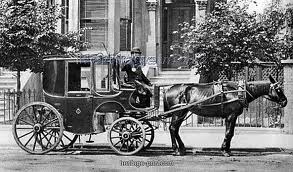
From The Horse-World of London by William John Gordon (1893)
Thousands of horses are imported and exported annually. So great is the Continental trade, that at Harwich, for instance, the Great Eastern Railway Company have provided stabling for eighty horses, which is frequently full. As many as 120 have been sent across the sea in one boat, most of them being Irish; indeed, the whole Belgian army used to be horsed from Ireland, the shipments, of course, going direct. We import mostly for the cheaper kinds of work, and we export for hard work, breeding, and waste, and in a whisper be it mentioned, for various food preparations, though not largely for these last. Sometimes the exports exceed the imports; sometimes, and oftener, the balance is the other way; though it is always on the right side as far as cash is concerned, for the imported horses average 111. as their value, while the exported horse is worth 54L In 1890, 19,400 horses came into this country and 12,900 went out; in 1889, 13,800 came in and 14,200 went out; and in three years the exports realised 2,532,000L, while the imports were declared at only 804,000L In 1876, when our horse-world was in a bad way, as many as 40,700 came in, but the imports have ever since shown a tendency downwards. Of these foreigners London has always taken the largest share. They are of all classes. On one occasion Tattersall's sold a batch of carriage horses from the States—good upstanding animals of sixteen hands or more, with good teeth and the uncut tail so much valued by jobmasters for their fashionable hirers, and these fetched in some cases 80 and 120 guineas. But the bulk of our imports are not of this quality, and come from nearer home. The draught horses come in from Denmark, Holland, Belgium, and Prance; the ponies from Norway and Sweden, and East Russia and Poland and Finland; the riding and driving horses from Hanover and Hungary. Some, as we have seen, come from the United States, some from Canada—the Canadian horse having many admirers—and even the South American mustang and the South Russian tarpan have figured in the carriages with less than four wheels licensed by the Board of Inland Revenue.
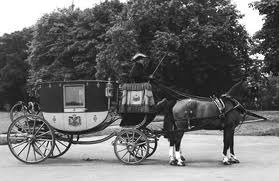 It is the general opinion that our carriage horses are not as good as they used to be, and we are told of the wonderful work that was accomplished by them before the railway monopolised the long-distance passenger traffic. A carriage horse that travels a hundred miles a week is now thought to be a treasure, but many horses in the past did fifty miles a day. The travelling carriage with its two horses would then do about ten miles at the rate of six or seven miles an hour, and halt for a quarter of an hour, during which the horses would wash out their mouths and eat a wisp of hay; the next stage would be about six miles, when there would be a halt for half an hour, during which the horses would be unharnessed and rubbed well down and fed with half a peck of corn; at the end of another ten miles there would be a halt of a quarter of an hour and a bait as before; at the end of six miles further there would be a halt of two hours, during which the horses would have both hay and corn; then would come another ten-mile stage, ending with a quarter of an hour's bait; and then would come the remaining eight miles, at the end of which the horses would have a mash before their night meal. This was the way people travelled when George the Fourth was King, or perhaps it would be more correct to say, 'the way some people travelled,' for it is clear enough that this sort of horse was the exception and not the rule. Of course, a large number went by post-horses; and then there was the coach traffic, so curiously limited in its capacity.There are coaches now; even during the winter there are half-a-dozen working on the roads to and from London; but these coaches can hardly be taken seriously as representing the coach of those 'glorious old days,' the recollection of which has lasted so much longer than their existence.
It is the general opinion that our carriage horses are not as good as they used to be, and we are told of the wonderful work that was accomplished by them before the railway monopolised the long-distance passenger traffic. A carriage horse that travels a hundred miles a week is now thought to be a treasure, but many horses in the past did fifty miles a day. The travelling carriage with its two horses would then do about ten miles at the rate of six or seven miles an hour, and halt for a quarter of an hour, during which the horses would wash out their mouths and eat a wisp of hay; the next stage would be about six miles, when there would be a halt for half an hour, during which the horses would be unharnessed and rubbed well down and fed with half a peck of corn; at the end of another ten miles there would be a halt of a quarter of an hour and a bait as before; at the end of six miles further there would be a halt of two hours, during which the horses would have both hay and corn; then would come another ten-mile stage, ending with a quarter of an hour's bait; and then would come the remaining eight miles, at the end of which the horses would have a mash before their night meal. This was the way people travelled when George the Fourth was King, or perhaps it would be more correct to say, 'the way some people travelled,' for it is clear enough that this sort of horse was the exception and not the rule. Of course, a large number went by post-horses; and then there was the coach traffic, so curiously limited in its capacity.There are coaches now; even during the winter there are half-a-dozen working on the roads to and from London; but these coaches can hardly be taken seriously as representing the coach of those 'glorious old days,' the recollection of which has lasted so much longer than their existence.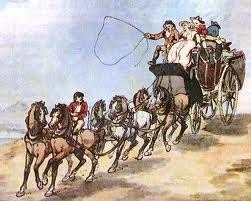
The mails have been carried by train for a longer period than they were carried by coach. The first mail coach appeared in August 1784, it having been then introduced by Major Palmer, the Duke of Richmond's son-in-law. What may be called the dominant idea of his invention was the cutting up of the road into short stages so as to change horses every ten miles, and use just as many horses as there were miles to be travelled. About 1835, when coaching was in its prime, there were seven hundred coaches at work, and these averaged ten miles an hour. Each horse ran for only one hour in the twenty-four, and stayed at home on the fourth day. He lasted about four years, and he cost 25Z. to buy; but the horses used within the tenmile radius of the large towns were very different from the roughish cattle that took their places along the country stretches. Nowadays our coaches are horsed with teams of level excellence all the way down. To horse the Brighton coach of 1891 forty-five horses were used, and these at Aldridge's realised under the hammer 3,811 guineas, or an average of 85 guineas each. In 1877 the Brighton stud fetched 80L each; in 1878 they fetched 75L; in 1885 the Guildford horses fetched 74L 10s. each, and next year the Windsor horses fetched over 601. The truth is that our modern coachhorses are really hunters, while the business coachhorse of the past was more of an omnibus horse. Of course the only coach-horses that come into our London 'world' are those used on the home stage, and their number is insignificant in a herd of hundreds of thousands such as that with which we are dealing.
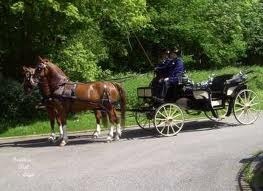
As with the horses so with the coach. The present coach is merely a drag for passengers only, and differs greatly from the old mail, which went swinging along, with a lurch every now and then, no matter how cleverly it might be ballasted. Its fore boot was full of parcels, so was its hind boot; its roof was piled up with baggage, with a tarpaulin lashed over the pile; game and baskets were hung on to its lamp irons; and underneath it was a 'cradle' of more luggage, all carefully packed, it is true, but giving a very different look to the whole affair than we get to-day in the handsome drags that leave the Metropole. The coaches, as now, were mostly supplied by contract. Vidler of Millbank was the great man, and he used to sell them right out at 140 guineas, or lend them out at so much a mile. And the horses were also hired out. Chaplin was the largest contractor; he had 1,700 horses at one time at work on the roads out of London. Horne was another contractor in an expansive way; he, like Chaplin, had been a driver, and the time came when he became his partner, and dropping coaching took to cartage, for which, as Chaplin and Home, they became better known.
As London now has its Cart-horse Parade, it had then its parade of mail coaches, which took place at Millbank, where the coaches were mostly built and the harness made. It was held on May Day, and brought together all the large London coach proprietors, the Sherborns, the Hearnes, the Faggs, and others, men who prided themselves on the fact that nowhere in the world were to be found such horses, such coaches, such drivers, or such guards. 'The coaches and harness were either new or newly painted and furnished,' says Mr. J. K. Fowler in his interesting Echoes of Old Country Life, 'the horses in the pink of condition and beauty, the coachmen and guards in new liveries of scarlet and gold, each proprietor vieing with his opponent in an endeavour to produce the most perfect turn-out. Critics abounded, and the judges gave the awards unbiassed by any predilections for the teams which passed through their respective districts. The procession started, and dense crowds of spectators thronged the route from Westminster, through the Strand, Fleet Street, and Ludgate Hill, by the Old Bailey, to the General Post Office.'
Published on August 02, 2011 23:31
The Royal Wedding - Another View
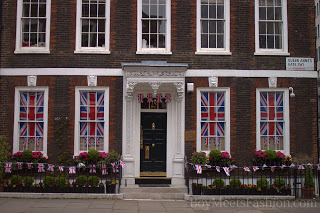
Check out the Boy Meets Fashion blog to see "on the ground" photos of the Royal Wedding Day - up close and personal views of how Londoner's celebrated the day.
Published on August 02, 2011 00:47
July 31, 2011
The Carriage Horse
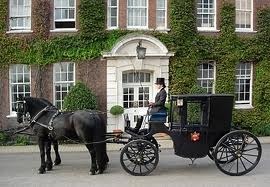
From The Horse-World of London by William John Gordon (1893)
A Four-horse coach weighs a ton; a single brougham, the lightest close carriage built, weighs about seven hundredweight: the carriage horse has thus not much of a weight to pull, but he has to pull it at a good pace, and it is the pace that kills. In quick work nowadays it is as much as an average carriage horse can do to travel fourteen miles a day for five days only of the week.
Eighty per cent. of the magnificent animals that draw the family coaches to the Queen's drawing-rooms are on hire from the jobmaster. If you keep them and shoe them yourself at your own stables, you can get them for a hundred guineas a year; if you want them only from April to July, you will be lucky to get them for six guineas a week, taking them by the month; or if you want them in the off season, you can, perhaps, have them cheap at sixteen guineas a month. If the jobmaster keeps them and shoes them at his stables, his charge is nearly double. This is for what is known as 'state coach horses,' but good carriage horses cost as much. Some jobmasters will provide you with brougham and horse, and everything but the coachman's livery, for 200L a year, but only on the condition that you never go outside the seven-miles radius from Charing Cross. In fact, the first-class carriage horse is a somewhat unsatisfactory investment ; it is safer to hire than to buy him; and hence the importance of the jobmaster in the horse-world of London.
There are some of the London jobmasters with 500 pairs out among the carriage folk, and several with over a hundred pairs. These horses are nearly all geldings, and they almost all begin their carriage work when they are four and a half years old; if they are bought before, they have to be kept till fit, which is another way of saying that there is little monetary advantage in buying them young, as the cost of their keep increases their price. Out of each thousand, three hundred are cleared out of the stables in a year to the auction mart, and about twenty-five die from accident or disease.
How many carriage horses are there in London? By the courtesy of the Board of Inland Revenue we are enabled to speak precisely with regard to the number of carriages. During the year ending March 31, 1891, the number of carriage licences issued within the Administrative County of London was 22,204. Of these, 7,955 were for carriages with four or more wheels drawn by two or more horses; 7,535 for carriages with four or more wheels but fitted to be drawn by one horse only, and 6,714 for carriages with less than four wheels. Of course, this is independent altogether of the hackney carriages which are given in the Metropolitan Police report, and of all vehicles, carts, vans and otherwise, used in trade. These carriages have probably about forty thousand horses, varying in value from the twenty-guinea pony up to the four-hundred-guinea state-coach horse; to average them is almost impossible, although the lot would certainly represent more than 2,500,000L at present prices.
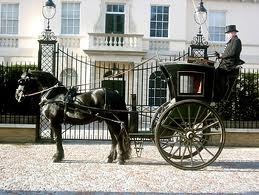
There are just double as many private carriages in London as there are cabs, and they range from the fifteen-guinea pony trap up to the three-hundred-guinea chariot, and beyond to the gorgeous official coaches including the Lord Mayor's carriage, which pays duty like the rest. How to sort out the proportions we candidly do not know, but if we adopt for the capital they represent the excellent principle suggested by Mr. Montague Tigg, 'and put down a one, and as many noughts as we can get in the line,' we shall have a million's worth, and average our vehicles at 45L each, which is about half what they are generally said to amount to.
Doubling the million, then, and adding to it the two millions and a half for the horses, and another half million for the stabling and harness, we arrive at five millions as the approximate value of the London private carriages and their horses, with their stables and coach-houses. In the last half million we are well enough within the mark to allow for any excess we may have made in the other items, for a set of pony harness will cost 51., and much of the double chariot harness seen in St. James's Street during a drawing-room is worth from thirty to forty pounds a set; and for stable accommodation the stock estimate is 151. per horse.
The stabling in a London mews has not the best of reputations, and its accommodation compares unfavourably with that obtainable at a country.town; in fact, it is owing in a great measure to the stable difficulty that so many people job their horses during the London season. The horse of pleasure is not like the horse of trade; he is worked at all hours, but rarely with regularity; he is kept healthy with exercise instead of work; and consequently he has to be carefully looked after, and wants the best of housing, which in London he does not always get.
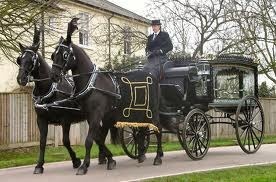
A large number of these showy carriage horses are Cleveland bays, bred in North Yorkshire and South Durham, such horses as in recent years have been sold at from 30Z . to 601. as stud-book foals, at from 501. to 701. as yearlings, and at from 601. to 1601. as two-yearolds. At one time the Cleveland mare was almost the only mother of our best carriage horses, but of late a good many of them trace their maternal pedigree through the Clydesdale breed, the result being a gain in hardiness and in the firmness and fitness of the feet for the hard paving of the town streets. But there are thousands which are neither Clevelands nor Clydesdales, and are bred from a Yorkshire coach-horse and a thoroughbred mare, or from the humble hackney stallion and half-bred mare, such as may occasionally be found in our omnibus and van stables. And there are thousands that are not home-bred at all. In every county in England the foreign ' machiner' will be found ousting the native, and in Hyde Park during the season he will be found in dozens. unmistakable though unlabelled, crawling along as leisurely as if his owner or hirer were like the great Earl of Chesterfield rehearsing a funeral.
Part Two Coming Soon!
Published on July 31, 2011 23:14
July 30, 2011
Travels with Victoria: Trooping the Colour 2011
[image error]
Trooping the Colour is held each June in celebration of the Queen's birthday (her actual birthday is April 21) and is a well-loved pageant. On Saturday, June 11, 2011, I could not resist going to the Mall to watch the procession of troops, bands, cavalry and royal carriages from Buckingham Palace to Horse Guards and back.
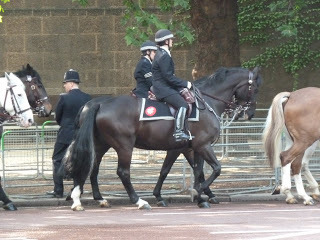 First to patrol the processional route were the police who stood every few yards with their automatic machine guns near the red-coated guards. The difference is that the soldiers, in their bearskin hats, had to remain at attention, or parade rest, while the police were far more casual.
First to patrol the processional route were the police who stood every few yards with their automatic machine guns near the red-coated guards. The difference is that the soldiers, in their bearskin hats, had to remain at attention, or parade rest, while the police were far more casual.
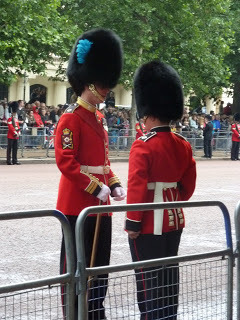 Inspection
Inspection
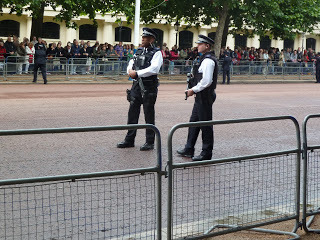 Keeping an eye out for trouble
Keeping an eye out for trouble
Today's ceremony Trooping the Colour has evolved from the ancient practice of assembling the soldiers before the battle and displaying the flag around which they are to rally in the midst of noise, confusion, smoke, flying shot and cannonballs in the battlefield. Each Trooping of the Colour displays for the Queen and assembled guests, as well as the massed military, a particular flag. On June 11, 2011, the colour trooped was the battle flag of the 1st Battalion Scots Guards.
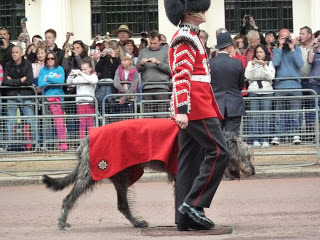 Leading the march down the Mall were the Irish Guards, here with their Irish Wolfhound mascot ahead of the troops.
Leading the march down the Mall were the Irish Guards, here with their Irish Wolfhound mascot ahead of the troops.
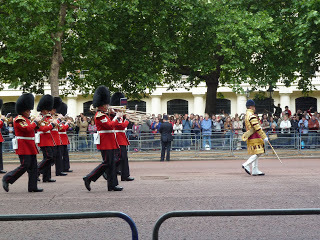 First of many bands.
First of many bands.
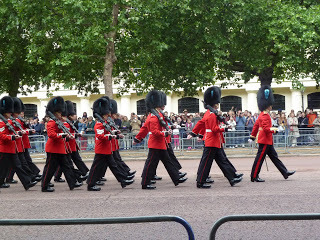 The Irish Guards can be identified by the blue plumes on their hats and by the arrangement of buttons on their tunics.
The Irish Guards can be identified by the blue plumes on their hats and by the arrangement of buttons on their tunics.
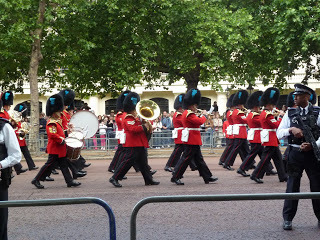 Band of the Irish Guards
Band of the Irish Guards
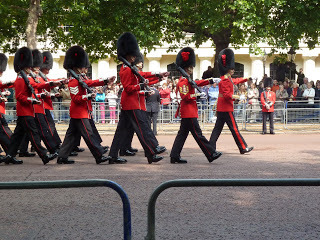
The Coldstream Guards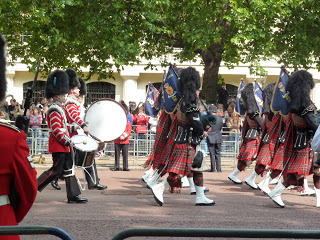 Band of the Scots Guards
Band of the Scots Guards
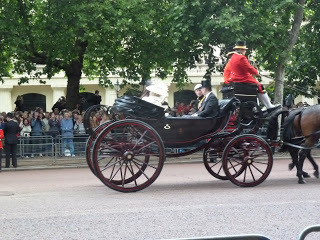 In this carriage: the Duchess of Cornwall in the big white hat, almost blocking the view of the Duchess of Cambridge; across from them are Prince Harry, on the left and the Duke of York.
In this carriage: the Duchess of Cornwall in the big white hat, almost blocking the view of the Duchess of Cambridge; across from them are Prince Harry, on the left and the Duke of York.
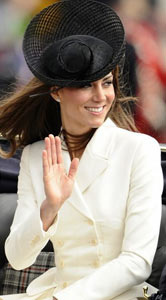 Above, a photo of the Duchess of Cambridge from the British Royals website.
Above, a photo of the Duchess of Cambridge from the British Royals website.
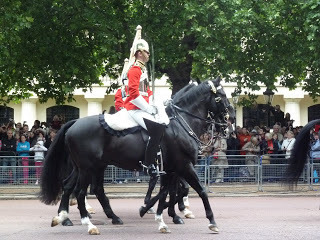 In addition to Foot Guards, the Household Cavalry was well represented; Above, members of the Life Guards.
In addition to Foot Guards, the Household Cavalry was well represented; Above, members of the Life Guards.
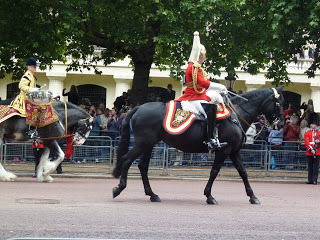 I love the drummers in the mounted bands; the horse's reins are attached to the stirrups so the rider can beat the time. See also the photo below.
I love the drummers in the mounted bands; the horse's reins are attached to the stirrups so the rider can beat the time. See also the photo below.
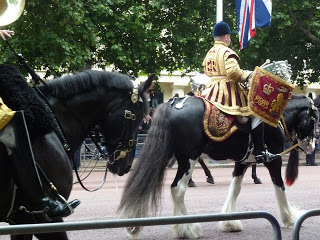
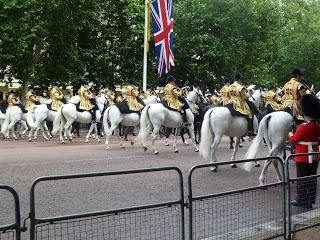 The mounted band of the Household Cavalry.
The mounted band of the Household Cavalry.
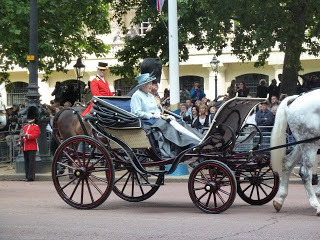 The Queen and Prince Philip, in his uniform as Colonel of the Grenadier Guards, ride in the carriage.
The Queen and Prince Philip, in his uniform as Colonel of the Grenadier Guards, ride in the carriage.
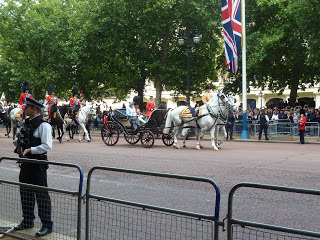 Behind the Queen's Carriage are, l-r, Prince William, Duke of Cambridge, in the uniform of Colonel of the Irish Guards; Prince Charles, Colonel of the Welsh guards; the Duke of Kent, Colonel of the Scots Guards; and Anne, Princess Royal, Colonel of the Household Cavalry's Blues and Royals.
Behind the Queen's Carriage are, l-r, Prince William, Duke of Cambridge, in the uniform of Colonel of the Irish Guards; Prince Charles, Colonel of the Welsh guards; the Duke of Kent, Colonel of the Scots Guards; and Anne, Princess Royal, Colonel of the Household Cavalry's Blues and Royals.
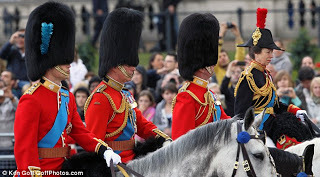 Here's a closer shot of the Queen's escort from the Daily Mail.
Here's a closer shot of the Queen's escort from the Daily Mail.
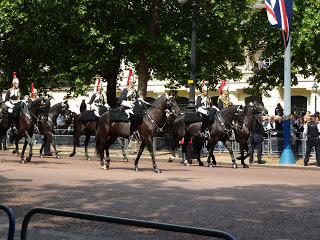 Finally, the Blues and Royals, in their blue tunics with red plumes, part of the Household Cavalry.
Finally, the Blues and Royals, in their blue tunics with red plumes, part of the Household Cavalry.
It was a magnificent parade; All the military and the Royals, along with hundreds of invited guests, were massed at Horse Guards Parade where the ceremony went on for just over an hour. While they were going through their paces, I left the crowd lining the Mall, most of whom were waiting for the return parade back to Buckingham Palace. But -- not having a lot of Saturdays to spend in London -- I decided not to wait but to explore further. Next, Marlborough House.
Trooping the Colour is held each June in celebration of the Queen's birthday (her actual birthday is April 21) and is a well-loved pageant. On Saturday, June 11, 2011, I could not resist going to the Mall to watch the procession of troops, bands, cavalry and royal carriages from Buckingham Palace to Horse Guards and back.
 First to patrol the processional route were the police who stood every few yards with their automatic machine guns near the red-coated guards. The difference is that the soldiers, in their bearskin hats, had to remain at attention, or parade rest, while the police were far more casual.
First to patrol the processional route were the police who stood every few yards with their automatic machine guns near the red-coated guards. The difference is that the soldiers, in their bearskin hats, had to remain at attention, or parade rest, while the police were far more casual. Inspection
Inspection Keeping an eye out for trouble
Keeping an eye out for troubleToday's ceremony Trooping the Colour has evolved from the ancient practice of assembling the soldiers before the battle and displaying the flag around which they are to rally in the midst of noise, confusion, smoke, flying shot and cannonballs in the battlefield. Each Trooping of the Colour displays for the Queen and assembled guests, as well as the massed military, a particular flag. On June 11, 2011, the colour trooped was the battle flag of the 1st Battalion Scots Guards.
 Leading the march down the Mall were the Irish Guards, here with their Irish Wolfhound mascot ahead of the troops.
Leading the march down the Mall were the Irish Guards, here with their Irish Wolfhound mascot ahead of the troops. First of many bands.
First of many bands. The Irish Guards can be identified by the blue plumes on their hats and by the arrangement of buttons on their tunics.
The Irish Guards can be identified by the blue plumes on their hats and by the arrangement of buttons on their tunics.  Band of the Irish Guards
Band of the Irish Guards

The Coldstream Guards
 Band of the Scots Guards
Band of the Scots Guards In this carriage: the Duchess of Cornwall in the big white hat, almost blocking the view of the Duchess of Cambridge; across from them are Prince Harry, on the left and the Duke of York.
In this carriage: the Duchess of Cornwall in the big white hat, almost blocking the view of the Duchess of Cambridge; across from them are Prince Harry, on the left and the Duke of York. Above, a photo of the Duchess of Cambridge from the British Royals website.
Above, a photo of the Duchess of Cambridge from the British Royals website. In addition to Foot Guards, the Household Cavalry was well represented; Above, members of the Life Guards.
In addition to Foot Guards, the Household Cavalry was well represented; Above, members of the Life Guards. I love the drummers in the mounted bands; the horse's reins are attached to the stirrups so the rider can beat the time. See also the photo below.
I love the drummers in the mounted bands; the horse's reins are attached to the stirrups so the rider can beat the time. See also the photo below.
 The mounted band of the Household Cavalry.
The mounted band of the Household Cavalry. The Queen and Prince Philip, in his uniform as Colonel of the Grenadier Guards, ride in the carriage.
The Queen and Prince Philip, in his uniform as Colonel of the Grenadier Guards, ride in the carriage. Behind the Queen's Carriage are, l-r, Prince William, Duke of Cambridge, in the uniform of Colonel of the Irish Guards; Prince Charles, Colonel of the Welsh guards; the Duke of Kent, Colonel of the Scots Guards; and Anne, Princess Royal, Colonel of the Household Cavalry's Blues and Royals.
Behind the Queen's Carriage are, l-r, Prince William, Duke of Cambridge, in the uniform of Colonel of the Irish Guards; Prince Charles, Colonel of the Welsh guards; the Duke of Kent, Colonel of the Scots Guards; and Anne, Princess Royal, Colonel of the Household Cavalry's Blues and Royals. Here's a closer shot of the Queen's escort from the Daily Mail.
Here's a closer shot of the Queen's escort from the Daily Mail. Finally, the Blues and Royals, in their blue tunics with red plumes, part of the Household Cavalry.
Finally, the Blues and Royals, in their blue tunics with red plumes, part of the Household Cavalry.It was a magnificent parade; All the military and the Royals, along with hundreds of invited guests, were massed at Horse Guards Parade where the ceremony went on for just over an hour. While they were going through their paces, I left the crowd lining the Mall, most of whom were waiting for the return parade back to Buckingham Palace. But -- not having a lot of Saturdays to spend in London -- I decided not to wait but to explore further. Next, Marlborough House.
Published on July 30, 2011 02:00
July 29, 2011
Trembleuse Cups and Saucers
[image error]
Copyright Worthopedia
Recently, I was watching the British version of Antiques Roadshow and saw an example of a Trembleuse cup and saucer being appraised. I had never heard of these items and it fascinated me. Which prompted me to think that they would, perhaps, fascinate you, too, so I decided to share a few of these gorgeous pieces.
Trembleuse cups and saucers were specifically designed for a person who suffered from the trembles and were virtually "spillproof." The example above was made by Royal Worcester and is marked with a date symbol for the year 1882. It is printed under the glaze in a beautiful rich blue and decorated with gold trim. The cup has a molded handle. Note both the deep inset of the saucer in which the cup firmly rests and the saucer's very wide border, all of which was designed to avoid spilling of the hot liquid by a trembling hand.
[image error] Copyright J. Paul Getty MuseumIn the 1700s, this double-handled cup pictured above would probably have been used to serve coffee or hot chocolate. Following the Chinese and Japanese custom, Europeans in the 1700s usually drank tea from small handless bowls.
Cups made at the Du Paquier porcelain manufactory were tall, higher than they were wide, and could be unstable. For this reason, the factory developed a trembleuse (literally "trembling") form, in which a raised ring or basket on the saucer held the cup in place and prevented spillage caused by a shaky hand.
Porcelain painters often imitated engravings with black enamel decoration known as schwarzlot; this decoration was typical of the Du Paquier factory.
[image error] Copyright the Victoria and Albert Collection
[image error] Circa 1775 Copyright The Lessing Photo Archive
[image error] Royal Worcester 1878 - Copyright Trocadero.com
[image error] 19th century cranberry glass copyright Miller's Antiques
It seems to me that a Trembleuse is exactly what poor Liz needed whenever she went for coffee at her neighbor, Hyacinth Bucket's house! (That's Bouquet) By the bye, the pair of cups and saucers on Antiques Roadshow were valued at five thousand pounds.
Recently, I was watching the British version of Antiques Roadshow and saw an example of a Trembleuse cup and saucer being appraised. I had never heard of these items and it fascinated me. Which prompted me to think that they would, perhaps, fascinate you, too, so I decided to share a few of these gorgeous pieces.
Trembleuse cups and saucers were specifically designed for a person who suffered from the trembles and were virtually "spillproof." The example above was made by Royal Worcester and is marked with a date symbol for the year 1882. It is printed under the glaze in a beautiful rich blue and decorated with gold trim. The cup has a molded handle. Note both the deep inset of the saucer in which the cup firmly rests and the saucer's very wide border, all of which was designed to avoid spilling of the hot liquid by a trembling hand.
[image error] Copyright J. Paul Getty MuseumIn the 1700s, this double-handled cup pictured above would probably have been used to serve coffee or hot chocolate. Following the Chinese and Japanese custom, Europeans in the 1700s usually drank tea from small handless bowls.
Cups made at the Du Paquier porcelain manufactory were tall, higher than they were wide, and could be unstable. For this reason, the factory developed a trembleuse (literally "trembling") form, in which a raised ring or basket on the saucer held the cup in place and prevented spillage caused by a shaky hand.
Porcelain painters often imitated engravings with black enamel decoration known as schwarzlot; this decoration was typical of the Du Paquier factory.
[image error] Copyright the Victoria and Albert Collection
[image error] Circa 1775 Copyright The Lessing Photo Archive
[image error] Royal Worcester 1878 - Copyright Trocadero.com
[image error] 19th century cranberry glass copyright Miller's Antiques
It seems to me that a Trembleuse is exactly what poor Liz needed whenever she went for coffee at her neighbor, Hyacinth Bucket's house! (That's Bouquet) By the bye, the pair of cups and saucers on Antiques Roadshow were valued at five thousand pounds.
Published on July 29, 2011 00:12
July 28, 2011
Travels with Victoria: A Visit to Strawberry Hill
Horace Walpole (1717-1797) was the epitome of the 18th century man: author, collector, designer and architect, politician, diarist, raconteur -- you know, the best of those "sees all, knows all, tells all" fellows. His Strawberry Hill gothic fantasy in Twickenham (website here) has received a major renovation and is open to the public; from central London, it's a short train ride and brief walk.
[image error]
One of Walpole's accomplishments was the "invention" of the neo-Gothic movement, or Gothic Revival, in architecture, interior design, and literature. As the youngest son of Prime Minister Robert Walpole, he enjoyed a typical upper class childhood, attended Eton and Cambridge, took a Grand Tour, and entered Parliament while still in his 20's. Horace Walpole collected old glass, books, art and almost any sort of object from early England, and he was fascinated with Gothic architecture.
[image error]
Walpole acquired the house on this property in the 1740's and set about remodeling and adapting it for the next several decades. He continued his collecting of artifacts to adorn the rooms and it became the object of many visitors to tour the premises, so many that he complained about their invasion of his privacy. But before the intrusions got so bad, he had another "invention" up his sleeve. In 1765 he published The Castle of Otrano, first in a continuing tradition of "Gothick" literature, popular even today in various forms.
[image error] Having no direct heirs, and being the last of the Earls of Orford, he left the house to his friend, sculptress and society leader Anne Damer. Later it fell into disrepair, was sold and the collections dispersed. For the last decades, it has been a part of St. Mary's University College. The Strawberry Hill Trust secured £9 million for the restoration project, which opened in October, 2010.
[image error]
Above, a window, showing how Walpole incorporated his collection of Renaissance and older glass into his modern 18th century windows. Last year, in 2010, I was fortunate enough to visit the wonderful exhibition at the Victoria and Albert Museum in London: Horace Walpole and Strawberry Hill. The exhibition, also shown at the Yale Center for British Art, reassembled many of the objects Walpole have collected but which were dispersed in a multi-day sale in 1842. Below, a cabinet of miniatures and enamels made for Walpole and now owned by the V&A. Inside, it was full of his treasures.
[image error]
Most of these objects and much of the interior furnishings remain in other collections, both private and in museums, but gradually the Trust hopes to secure some loans and gifts of the originals. For the time being, while the renovations continue, the rooms are empty.
[image error]
Above, the library in 2011; below, the library as Walpole enjoyed it.
[image error]
There are, however, some amenities: the gift shop and the restaurant, both of which enjoyed our custom. Due to the nature of the building, it is necessary to book visits in advance or risk a long wait. In 1784,Walpole wrote a guide to Strawberry Hill. A reproduction of this guide is given to each visitor. Walpole wrote: "In truth, I did not mean to make my house so Gothic as to exclude convenience, and modern refinements in luxury...It was built to please my own taste, and in sole degree to realize my own vision."
[image error]
[image error] The staircase from below and from above. From Walpole's 1784 guide: "In the well of the staircase, by a cord of black and yellow, hangs a Gothic lantern of tin japanned, designed by Mr. Bentley and filled with painted glass..."
Below, I have arranged my photos in groups of architectural features. If you'd rather see each room, one by one, click here. More of the windows, incorporating Walpole's colorful collections of glass:
[image error]
[image error]
[image error]
Also of note are the various designs for fireplaces.
[image error] The Great Parlor
[image error] The Blue Bed Chamber
[image error] The Holbein Chamber
[image error] The Gallery
The ceilings were brilliantly executed - and restored.
[image error] The Library
[image error]
[image error]
The Gallery, with a fan-vault ceiling inspired by Westminster Abbey's King Henry VII chapel, is brilliant; in the restoration, the papier mache forms were refreshed and regilded.
[image error]
Finally, a few shots of the exterior. The garden is being re-developed, and it has a way to go. The white canvas at the lower right was part of a tent used for a party the previous evening and in the process of removal.
[image error]
The roof.
[image error]
We searched for a while before a kind St. Mary's faculty member directed us to the chapel, now hidden beyond a car park. The design is based on the tomb of Edmund Audley, bishop of Salisbury in the Cathedral there.
[image error]
For more posts on Horace Walpole, see our blogs of 4/20/10, 4/7/11, 5/11/11, 5/28/11, 6/8/11, and 6/19/11.
[image error]
One of Walpole's accomplishments was the "invention" of the neo-Gothic movement, or Gothic Revival, in architecture, interior design, and literature. As the youngest son of Prime Minister Robert Walpole, he enjoyed a typical upper class childhood, attended Eton and Cambridge, took a Grand Tour, and entered Parliament while still in his 20's. Horace Walpole collected old glass, books, art and almost any sort of object from early England, and he was fascinated with Gothic architecture.
[image error]
Walpole acquired the house on this property in the 1740's and set about remodeling and adapting it for the next several decades. He continued his collecting of artifacts to adorn the rooms and it became the object of many visitors to tour the premises, so many that he complained about their invasion of his privacy. But before the intrusions got so bad, he had another "invention" up his sleeve. In 1765 he published The Castle of Otrano, first in a continuing tradition of "Gothick" literature, popular even today in various forms.
[image error] Having no direct heirs, and being the last of the Earls of Orford, he left the house to his friend, sculptress and society leader Anne Damer. Later it fell into disrepair, was sold and the collections dispersed. For the last decades, it has been a part of St. Mary's University College. The Strawberry Hill Trust secured £9 million for the restoration project, which opened in October, 2010.
[image error]
Above, a window, showing how Walpole incorporated his collection of Renaissance and older glass into his modern 18th century windows. Last year, in 2010, I was fortunate enough to visit the wonderful exhibition at the Victoria and Albert Museum in London: Horace Walpole and Strawberry Hill. The exhibition, also shown at the Yale Center for British Art, reassembled many of the objects Walpole have collected but which were dispersed in a multi-day sale in 1842. Below, a cabinet of miniatures and enamels made for Walpole and now owned by the V&A. Inside, it was full of his treasures.
[image error]
Most of these objects and much of the interior furnishings remain in other collections, both private and in museums, but gradually the Trust hopes to secure some loans and gifts of the originals. For the time being, while the renovations continue, the rooms are empty.
[image error]
Above, the library in 2011; below, the library as Walpole enjoyed it.
[image error]
There are, however, some amenities: the gift shop and the restaurant, both of which enjoyed our custom. Due to the nature of the building, it is necessary to book visits in advance or risk a long wait. In 1784,Walpole wrote a guide to Strawberry Hill. A reproduction of this guide is given to each visitor. Walpole wrote: "In truth, I did not mean to make my house so Gothic as to exclude convenience, and modern refinements in luxury...It was built to please my own taste, and in sole degree to realize my own vision."
[image error]
[image error] The staircase from below and from above. From Walpole's 1784 guide: "In the well of the staircase, by a cord of black and yellow, hangs a Gothic lantern of tin japanned, designed by Mr. Bentley and filled with painted glass..."
Below, I have arranged my photos in groups of architectural features. If you'd rather see each room, one by one, click here. More of the windows, incorporating Walpole's colorful collections of glass:
[image error]
[image error]
[image error]
Also of note are the various designs for fireplaces.
[image error] The Great Parlor
[image error] The Blue Bed Chamber
[image error] The Holbein Chamber
[image error] The Gallery
The ceilings were brilliantly executed - and restored.
[image error] The Library
[image error]
[image error]
The Gallery, with a fan-vault ceiling inspired by Westminster Abbey's King Henry VII chapel, is brilliant; in the restoration, the papier mache forms were refreshed and regilded.
[image error]
Finally, a few shots of the exterior. The garden is being re-developed, and it has a way to go. The white canvas at the lower right was part of a tent used for a party the previous evening and in the process of removal.
[image error]
The roof.
[image error]
We searched for a while before a kind St. Mary's faculty member directed us to the chapel, now hidden beyond a car park. The design is based on the tomb of Edmund Audley, bishop of Salisbury in the Cathedral there.
[image error]
For more posts on Horace Walpole, see our blogs of 4/20/10, 4/7/11, 5/11/11, 5/28/11, 6/8/11, and 6/19/11.
Published on July 28, 2011 02:00
July 27, 2011
For Sale: Period Perfection in Bath
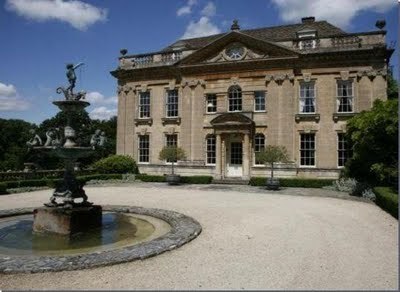
It is time once again to share with you yet another period property of perfection. Read on and weep. I know I'm sobbing as I write this. Sigh.
Set amid an idyllic valley just minutes from the heart of Bath, Widcombe Manor is an enchanting and historic residence. It is also a comfortable and peaceful family home. Constructed of Bath stone, it is a Grade I listed building, and regarded as one of the finest examples of Georgian architecture in the South West. The estate and house are immersed in history. Early records have it built on the site of a grange for the abbots of Bath. On the dissolution of the monasteries, the estate was owned by Richard Chapman, a rich clothier and Mayor of Bath. The original house was built in 1656, and was most likely to have been designed by Inigo Jones(sob). It was remodelled in 1727 for Chapman's grandson, Philip Bennet, and the crest of the Bennet family still sits atop two pedestals at the magnificent entrance gates. Famous visitors include Henry Fielding, who wrote his classic novel Tom Jones while staying here, and, in more recent times, A-list celebrities and party-goers such as Cecil Beaton, Princess Margaret and Lord Snowdon. Today, it's a comfortable retreat in a fascinating and historic city. (Aaarrgghhhh!)
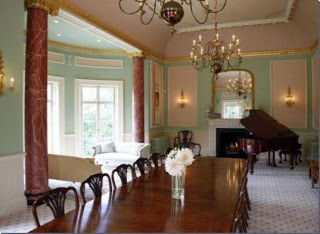
Period Features
Widcombe Manor is the finest Georgian home in Bath, and the attention to detail is second to none. The Georgian facade, with its elaborate and highly decorative stonework, is a breathtaking sight and is complemented perfectly by a bronze 15th Century Venetian-style fountain. The interior has been sensitively refurbished in recent years and retains historical features, such as an Elizabethan mahogany staircase and ornate cornices (sniff, snuffle, sniff). Panelling, oak flooring and elegant statuary are featured through the house to create the feel of an elegant yet welcoming country home that is ideal for entertaining, as well as family life. Modern touches, such as an internal water garden, create a delightful design statement.
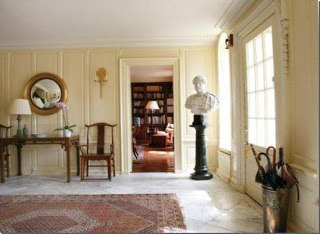
Spacious Living - The Ground Floor
This unique residence offers the flexibility to combine family life with business enterprise. The beautiful and spacious panelled hallway leads to a number of rooms including a library with leather flooring (be still my heart!) and a spacious study/office. The large, comfortable family sitting room has a bay window which offers superb views over the landscaped gardens and woodland of surrounding Lyncombe Vale. The kitchen and breakfast room are ideal for informal entertaining and large French windows open to the sun terrace and outdoor dining area. For more formal occasions, the dining room is an intimate and atmospheric space to welcome guests. The basement has been sensitively renovated to provide a large open games room as well as a wine cellar. A further play area overlooks a courtyard which was added by the current owners and built in Bath stone with an elegant fountain. There is parking for three cars in the garage, and a utility room and plant room complete the ground floor. A staff cottage is situated close to the house and has a living room, kitchen, bedroom and bathroom. (I'm completely out of Kleenex!)
Beautiful Views - The Upper Floors
Widcombe Manor has been designed so that owners can enjoy views of its exquisite grounds from all the main reception rooms. The views are particularly superb from the magnificent drawing room, situated on the first floor, which overlooks the lakes and cascade. Decorated in tones that echo the Georgian elegance of Bath's Assembly Rooms, the room also features elegant touches such as gilt cornicing, bay windows and a painted ceiling. South-facing, it offers views over all nine acres of the estate and the vale beyond. It is the perfect place to enjoy the everchanging colours of the seasons in the surrounding mature woodland and formal terraces. Most of the main reception rooms are south-facing over the estate and the Bath stone is particularly beautiful when bathed in gentle sunlight at dawn and dusk. The panelled landing is an elegant feature and affords views over the Venetian fountain, as does the second floor office, which has a beautiful oval window. (Howl!)
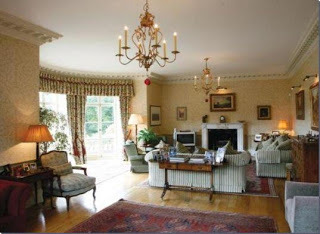
Comfort and Style - The Bedroom Suites
Widcombe Manor is a home that represents the perfect marriage of grandeur and comfort, and nowhere is that more evident than in its three exquisite bedroom suites. These spacious and beautifully designed rooms are ideal for guests or family living. The master bedroom is a light, airy room which offers beautiful views over the woodland and gardens. This leads on to a dressing area and Grecian-themed marble bathroom. A further delightful guest suite overlooks the courtyard and fountain to the front of the house, and has a large en suite bathroom with roll-top bath. Decorated in subtle tones, with delightful dressings, furnishing and cream panelling, this is a relaxing retreat.
The manor has a further guest bedroom on the first floor which overlooks the gardens and has a stylish en suite bathroom. On the second floor there are three more bedrooms and two bathrooms, which are ideal family rooms. (You can all come to stay!). Tucked away in the eaves of the house, they are characterful and intimate, yet offer the spaciousness required for family living.
Modern Luxury - The Pavilion
Amid the Georgian splendour of this residence, the modernist garden Pavilion provides an exciting departure in terms of design, and was influenced by the Mies van der Rohe-designed Barcelona Pavilion. Situated to the east of the residence, it is a large, light-filled space with kitchen and dining area, and an informal living room. Its huge glass doors slide back to reveal breathtaking views of the woodland and lakes, creating a sense of being at one with the natural world. A large heated infinity pool reflects the tones of woodland surrounding the Pavilion and offers fabulous views over the vale and gardens. A grass 'staircase' leads down from this perfect suntrap to the terraces and more formal areas (stop! You're killing me!). In perfect contrast is the Georgian Summerhouse, a delightful and spacious garden room built in Bath stone. Situated along a long walk, with wellstocked herbaceous borders, it provides a formal and elegant focal point amid the terraces close to the house. It is also spacious enough to be the ideal place to serve tea on a hot, sunny day. (Can this pile posssibly be more appealing?!)
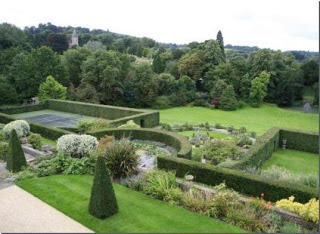
Exquisite landscapes - Garden and Grounds
Widcombe Manor's nine-acre gardens are a central attraction in this enchanting retreat. Terraced and landscaped in the 18th Century they were developed into their current form in the 1930s, with some further redevelopment in the 1990s, and include lakes, a cascade (wanted: one hermit for live in position), formal gardens, a croquet lawn and tennis court. The Italianate gardens near the house provide a suitably formal and architectural extension of the Georgian splendour of the house. Elegant topiary, statues, fountains and immaculate lawns are complemented by architectural plants as well as well-established perennials. The formality gives way to a vale which leads down to the lakes and cascade. Mature woodland provides perfect privacy and an everchanging panoply of colour and interest throughout the seasons. A children's play area and a bountiful cutting garden are other features that enhance the estate's attraction, and a boules court is another delightful addition from the current owners.
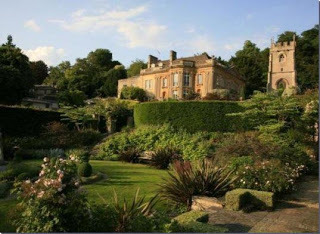
The soothing sounds of natural, flowing water from the waterfall enhance the sense of rural tranquillity in a residence that is just minutes from the many cultural attractions of Bath. (Oh, the humanity!)
Offered for sale by Savills Bath - offers in excess of £10,000,000
Reader, I am spent.
Published on July 27, 2011 00:59
July 26, 2011
Travels with Victoria: Penshurst Place
[image error]
As long as I have been interested in English Country Houses, I have yearned to visit Penshurst Place in Kent, near Tonbridge. It was definitely worth waiting for. Their website is here.
[image error]
On a warm sunny day in early June 2011, we were greeted by a local organic food fair outside the entrance. I wanted to browse, but I was far too eager to get to the house and gardens. From the looks of the crowd, however, they were doing a good business in eggs, meat, poultry, veggies and ciders.
[image error]
When I took a course on English Country Houses at Oxford, one of the prime examples presented of the ancient fortified manor house was Penshurst Place. Though many others still exist, the Baron's Hall (built 1341) is, according to the guidebook and my don (professor), "the best preserved example of 14th century domestic architecture in England."
[image error] This is where the members of the household lived, ate, slept -- and died. The fire pit in the center of the hall was vented through the roof, so it would have been smoky, as well as crowded, smelly, and noisy. If danger threatened, many more people -- farmers, shepherds, villagers -- would crowd in for protection. The Lord of the Manor and his family ate at the High Table on a raised dais, but probably withdrew to the Solar for most of their activities.
[image error] The high pointed roof in the middle is the exterior of the Baron's Hall. Though the hall was originally built by Sir John de Pulteney, who incidentally was Lord Warden of the Cinque Ports, the enlarged house became the home of the Sidney family, various branches of which have owned it ever since.
[image error] National Portrait Gallery, London
Penshurst was the birthplace of Sir Philip Sidney (1554-1586), one of those amazing examples of the Renaissance man: courtier, statesman, soldier, and poet, known for his honor and virtue. There are hundreds of fascinating stories about the people who lived here, or wanted to: feuders, plotters of intrigue, scandalous characters, builders, and wastrels, as well as many government officials, country gentlemen and ladies who were sober and industrious -- and everything in between the miscreants and the gallants. The interiors of the house are fascinating, showing features from many centuries and reflecting the history of the family -- but again, there are no photos permitted. Why? Talk about cutting off your own nose, etc. Below, looks like somebody scanned the Long Gallery photo from the guidebook.
[image error]
And here's another interior, of the Panelled Room, with its magnificent bed.
[image error]
Below, the Nether Gallery, with its collection of arms and armor, from Country Life magazine.
[image error]
In the family tree of the current residents, the family of Viscount D'Isle and Dudley, are many of the most famous names in English history: Sidney, of course; Dudleys, Perrys, Shelleys, Spencers, and Churchills; Dukes of Northumberland; Lady Jane Grey; Earls of Leicester, Salisbury, Sunderland, and Bridgewater, and the Duke of Clarence, later King William IV. His daughter by the actress Dora Jordan, Lady Sophia FitzClarence, married Philip Sidney, 1st Lord L'Isle and
Dudley (1800-1856).
[image error] The gardens at Penshurst Place are spectacular.
[image error]
[image error]
There are many wings of the house which are not open to tourists, but I felt quite satisfied with seeing the oldest areas, which are impressively preserved. Bravo, Viscount D'Lisle!!
Travels with Victoria will journey to Horace Walpole's Strawberry Hill, next.[image error]
As long as I have been interested in English Country Houses, I have yearned to visit Penshurst Place in Kent, near Tonbridge. It was definitely worth waiting for. Their website is here.
[image error]
On a warm sunny day in early June 2011, we were greeted by a local organic food fair outside the entrance. I wanted to browse, but I was far too eager to get to the house and gardens. From the looks of the crowd, however, they were doing a good business in eggs, meat, poultry, veggies and ciders.
[image error]
When I took a course on English Country Houses at Oxford, one of the prime examples presented of the ancient fortified manor house was Penshurst Place. Though many others still exist, the Baron's Hall (built 1341) is, according to the guidebook and my don (professor), "the best preserved example of 14th century domestic architecture in England."
[image error] This is where the members of the household lived, ate, slept -- and died. The fire pit in the center of the hall was vented through the roof, so it would have been smoky, as well as crowded, smelly, and noisy. If danger threatened, many more people -- farmers, shepherds, villagers -- would crowd in for protection. The Lord of the Manor and his family ate at the High Table on a raised dais, but probably withdrew to the Solar for most of their activities.
[image error] The high pointed roof in the middle is the exterior of the Baron's Hall. Though the hall was originally built by Sir John de Pulteney, who incidentally was Lord Warden of the Cinque Ports, the enlarged house became the home of the Sidney family, various branches of which have owned it ever since.
[image error] National Portrait Gallery, London
Penshurst was the birthplace of Sir Philip Sidney (1554-1586), one of those amazing examples of the Renaissance man: courtier, statesman, soldier, and poet, known for his honor and virtue. There are hundreds of fascinating stories about the people who lived here, or wanted to: feuders, plotters of intrigue, scandalous characters, builders, and wastrels, as well as many government officials, country gentlemen and ladies who were sober and industrious -- and everything in between the miscreants and the gallants. The interiors of the house are fascinating, showing features from many centuries and reflecting the history of the family -- but again, there are no photos permitted. Why? Talk about cutting off your own nose, etc. Below, looks like somebody scanned the Long Gallery photo from the guidebook.
[image error]
And here's another interior, of the Panelled Room, with its magnificent bed.
[image error]
Below, the Nether Gallery, with its collection of arms and armor, from Country Life magazine.
[image error]
In the family tree of the current residents, the family of Viscount D'Isle and Dudley, are many of the most famous names in English history: Sidney, of course; Dudleys, Perrys, Shelleys, Spencers, and Churchills; Dukes of Northumberland; Lady Jane Grey; Earls of Leicester, Salisbury, Sunderland, and Bridgewater, and the Duke of Clarence, later King William IV. His daughter by the actress Dora Jordan, Lady Sophia FitzClarence, married Philip Sidney, 1st Lord L'Isle and
Dudley (1800-1856).
[image error] The gardens at Penshurst Place are spectacular.
[image error]
[image error]
There are many wings of the house which are not open to tourists, but I felt quite satisfied with seeing the oldest areas, which are impressively preserved. Bravo, Viscount D'Lisle!!
Travels with Victoria will journey to Horace Walpole's Strawberry Hill, next.[image error]
Published on July 26, 2011 02:00
July 25, 2011
The Wellington Connection - Walmer Castle
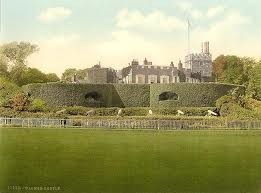 Walmer Castle, Kent
Walmer Castle, Kent
From The History of Walmer and Walmer Castle By Charles Robert Stebbing Elvin (1894)
The quiet unostentations life which the Duke of Wellington led at Walmer, has been familiarized to us by Earl Stanhope in his "Conversations." But one trait must be briefly alluded to, namely, the Duke's love for children, which was evinced in a characteristic manner. We are told by Lord Stanhope that, in the autumn of 1837, Wellington had staying with him at Walmer Castle, two little children of Lord and Lady Robert Grosvenor, a boy and girl, and these chicks having expressed a desire to receive letters through the post—it was before the days of the penny post—the Duke used to write to them every morning a letter containing good advice for the day, which was regularly delivered when the post came in. He used also constantly to play fooball with the little boy upon the ramparts.
It was in the October of this year that poor Haydon spent some days at the castle, having come down at the Duke's request, to paint his portrait for certain gentlemen at Liverpool. Haydon relates in his Diary, how charmed he was with the Duke's playfulness with "six dear healthy noisy children," no less than with his unostentatious reverence at the parish church on Sunday. . . . . It is further related of the Duke of Wellington, that he sometimes took out with him, in his walks, a number of sovereigns and half-sovereigns, each suspended from a red or blue ribbon, and that when he came upon a group of children, he would present them with one of these, either red or blue, according as they declared themselves when interrogated, to be for the army or navy. The Duke's early habits are well known, and an old gentlemen still living, tells me that when he was a boy at Walmer, he and his school-fellows used frequently in the summer, to be taken down to the sea near Walmer Castle, at six o'clock in the morning, to bathe, and the Duke would often come on the beach and converse with them.
In addition to children, the Duke also entertained more mature guests at the Castle -
The Duke of Wellington was repeatedly honoured with visits from Royalty, during his occupancy of Walmer Castle. Thus Earl Stanhope mentions in his Conversations his meeting Prince George of Cambridge (the present Duke) at dinner at Walmer Castle, on October 14th, 1833; and on October 17th, 1837, records a luncheon at the Castle to meet the Princess Augusta of Saxony.
From the same source, also, we learn that two years later the Duke of Cambridge (father of Prince George above-mentioned), and first Duke of Cambridge with the Duchess and Princess Augusta, spent five days at Walmer Castle, namely, from October 3rd to October 8th. And how they were entertained we are also informed. On the evening after their arrival, there was a dinner party of eighteen persons, followed by a concert, for which the Duke of Wellington had engaged several vocalists from London, and to which he invited most of the neighbours: another dinner given on the 6th Oct., was followed by a larger party still, and a concert in the evening: while on the last day of their sojourn, October 7th, a great public breakfast given by the Duke in their honour, at 2 p.m., was attended by from a hundred to a hundred and twenty persons, many of whom came from Ramsgate and Dover; and in the evening there was another concert and large party.
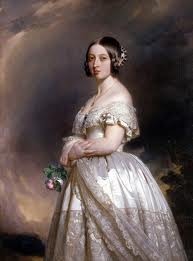
But the chief interest centres in the visits of our present beloved Queen, who first became acquainted with Walmer in 1835 ; in the autumn of which year, she being then the Princess Victoria and a girl of sixteen, paid a visit to the Duke of Wellington and lunched at the castle, with her mother, the Duchess of Kent, and the King and Queen of the Belgians.
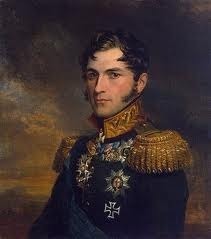 Leopold, King of the Belgians
Leopold, King of the Belgians
The following account of this visit has been preserved in a letter by the then Lady Burghersh to her husband :—" The King and Queen of the Belgians arrived exactly at 2 in the same carriage with the Dnchess of Kent and Princess Victoria. The Duke of Wellington and I went to meet them on the drawbridge, and brought them up the outside staircase to the ramparts (where nearly all the company were already assembled), the lower battery firing a salute. The scene was beautiful; the whole of the beach in front of the castle and the roads leading to Deal and to the village, were filled with people; all the colours hoisted at the different places along the coast and on the ships, of which, fortunately, there were quantities in the Downs. The only drawback was that we were disappointed of getting a band from Canterbury, so there was no music. After walking about the ramparts and speaking with the company, the King and Queen went with the Duke round the garden, but the Princess Victoria had a little cold; so I staid in the drawing room with her and the Duchess of Kent, and baby was brought in and behaved like a little angel, and was much admired. She was sent for again afterwards to see the Queen. As the crowd outside were eager to see Princess Victoria, I asked the Duchess of Kent if she thought she might come out for a moment to shew herself, and I fetched my ermine tippet for her, which she put on, and came out on the ramparts and was very much cheered."
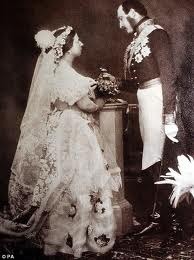
Seven years later we find her Majesty again at Walmer Castle; being no longer a girl, but a Queen and a mother. It was on the morning of Thursday, November 10th, 1842, that the Royal party, consisting of the Queen, Prince Albert, and their two children, the Prince of Wales and the Princess Royal, left Windsor Castle, accompanied by a distinguished suite, en route for Walmer Castle; where they arrived the same day escorted by a troop of the 7th Hussars, then quartered at Canterbury, and with a guard of honour furnished by the 51st Infantry. With the exception of the journey from Slough to Paddington, the whole distance was accomplished by road; Her Majesty being everywhere greeted with the most enthusiastic demonstrations of loyalty and esteem. On the outskirts of Upper Deal, the Royal Party were met by the Duke of Wellington, who afterwards rode on to receive Her Majesty and the Prince at Walmer Castle, which was then placed entirely at their disposal; the Duke proceeding to Dover to take up his quarters during the royal visit.
Although the accommodation at the castle was somewhat restricted, being much less in those days than at present, no effort was spared to ensure the comfort of the royal guests and their suite. Two of the principal rooms in the castle had been thrown into one, for the sleeping apartment of Her Majesty and the Prince; while the portion of the fortress appropriated for the royal nursery, consisted of four rooms in "the outworks or north tower," with the windows facing in a northerly direction. Viscount Sydney, as the Lord in Waiting, and Lady Portman as the Lady in Waiting, as well as the Honble. C. A. Murray, Master of the Household, and others, occupied some other rooms; while the rest of the guests were accommodated in a large house about three quarters of a mile away.
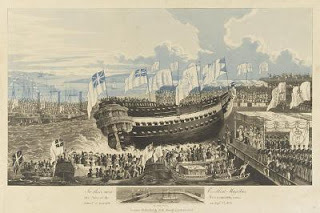 The Launch of The Thunderer, 1831
The Launch of The Thunderer, 1831
Copyright Port Cities London
The inhabitants of the whole district seem to have vied with each other in their efforts to do honour to the royal visitors; the illuminations throughout the neighbourhood being most brilliant. And on the following morning, when the royal standard was hoisted on Walmer Castle, the Thunderer manned yards, and saluted Her Majesty with twenty-one guns. The royal party remained at the castle nearly a month; and it was while here that the Queen received by special messenger from Downing Street, the news of the recapture of Ghuznee and Cabul, and the rescue of the prisoners.
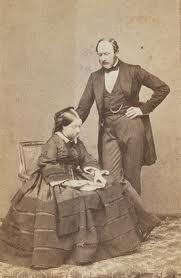
An incident took place during this visit, which displays, in a remarkable degree, the natural goodness of heart and kindliness of disposition, which have always been shewn by her Majesty in her intercourse with her people. The Queen and Prince Consort were one day walking on the shore in the direction of Kingsdown, when they were driven by a sudden shower to take refuge in an old boat-house, which, besides being a place for storing boat's gear, served also as a dwelling for an aged boatman—Thomas Erridge—and his wife; who, although they failed to recognize their visitors, readily offered them such mean accommodation as the place afforded. The royal pair were soon provided with a seat, consisting of some spars placed upon empty water-casks and covered with a spare sail; and there they sat and conversed with their simple-minded hosts, until the shower ceased ; and the latter were afterwards rewarded for their rude, but kindly hospitality, with a pension, with which the Queen provided them for the rest of their days.
The last meeting between Prince Albert and the Duke of Wellington, took place at Walmer Castle, on a similar occasion to the last, and only two years later. It was on August 17th, 1852, a month before the Duke's death: the royal squadron having anchored in the Downs for one night, with the Queen and the Prince Consort en route for Belgium, His Royal Highness landed in a small boat from the Victoria and Albert, and paid a visit to the castle, where he had a long conversation with the aged warrior and statesman.
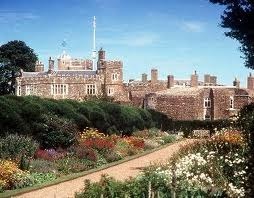
Whilst the Duke took excellent care of his many guests, he seems to have been rather more lenient in his care of the Castle gardens -
The next considerable improvement to the (Castle) grounds was made by the Earl of Liverpool (Warden before Wellington), who added the two meadows— since thrown into one—with the express proviso that, in the event of the office of Lord Warden being ever abolished, they should revert to the representatives of his own family.
The Duke of Wellington did not improve the grounds: on the contrary, he seems to have allowed them to fall into a state that would very much shock the professional gardener. But then the Duke's gardener was not a professional, but a veteran sergeant of the Peninsular Army, and a Waterloo man, named Townsend, who received his appointment to the post of gardener at Walmer Castle under the following peculiar circumstances. The story goes, that shortly after the Duke became Lord Warden, he received a letter from Sergeant Townsend, complaining that he had been discharged from the service without a pension: that thereupon he immediately replied, "Field Marshall the Duke of Wellington would be happy to see Sergeant Townsend at Apsley House -on Friday at noon ": that on the interview taking place, his Grace inquired, "Do you know anything about gardening?" and, on receiving a negative reply, added, "Then learn, learn, and come here this day fortnight at the same hour." The sergeant withdrew, and when, in obedience to orders, he appeared the second time at Apsley House, was greeted with—"Take the place of gardener at Walmer Castle; and on replying, "But I know nothing about gardening," was cut short by the Duke with "Nor do I, nor do I, take your place at once."
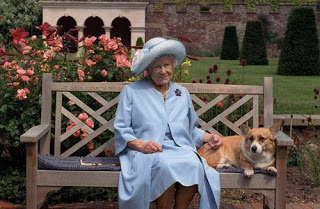 HM Queen Elizabeth the Queen Mother was Lord Warden for 24 years
HM Queen Elizabeth the Queen Mother was Lord Warden for 24 years
and spent many summers in residence at Walmer Castle.
[image error]
 Walmer Castle, Kent
Walmer Castle, Kent From The History of Walmer and Walmer Castle By Charles Robert Stebbing Elvin (1894)
The quiet unostentations life which the Duke of Wellington led at Walmer, has been familiarized to us by Earl Stanhope in his "Conversations." But one trait must be briefly alluded to, namely, the Duke's love for children, which was evinced in a characteristic manner. We are told by Lord Stanhope that, in the autumn of 1837, Wellington had staying with him at Walmer Castle, two little children of Lord and Lady Robert Grosvenor, a boy and girl, and these chicks having expressed a desire to receive letters through the post—it was before the days of the penny post—the Duke used to write to them every morning a letter containing good advice for the day, which was regularly delivered when the post came in. He used also constantly to play fooball with the little boy upon the ramparts.
It was in the October of this year that poor Haydon spent some days at the castle, having come down at the Duke's request, to paint his portrait for certain gentlemen at Liverpool. Haydon relates in his Diary, how charmed he was with the Duke's playfulness with "six dear healthy noisy children," no less than with his unostentatious reverence at the parish church on Sunday. . . . . It is further related of the Duke of Wellington, that he sometimes took out with him, in his walks, a number of sovereigns and half-sovereigns, each suspended from a red or blue ribbon, and that when he came upon a group of children, he would present them with one of these, either red or blue, according as they declared themselves when interrogated, to be for the army or navy. The Duke's early habits are well known, and an old gentlemen still living, tells me that when he was a boy at Walmer, he and his school-fellows used frequently in the summer, to be taken down to the sea near Walmer Castle, at six o'clock in the morning, to bathe, and the Duke would often come on the beach and converse with them.
In addition to children, the Duke also entertained more mature guests at the Castle -
The Duke of Wellington was repeatedly honoured with visits from Royalty, during his occupancy of Walmer Castle. Thus Earl Stanhope mentions in his Conversations his meeting Prince George of Cambridge (the present Duke) at dinner at Walmer Castle, on October 14th, 1833; and on October 17th, 1837, records a luncheon at the Castle to meet the Princess Augusta of Saxony.
From the same source, also, we learn that two years later the Duke of Cambridge (father of Prince George above-mentioned), and first Duke of Cambridge with the Duchess and Princess Augusta, spent five days at Walmer Castle, namely, from October 3rd to October 8th. And how they were entertained we are also informed. On the evening after their arrival, there was a dinner party of eighteen persons, followed by a concert, for which the Duke of Wellington had engaged several vocalists from London, and to which he invited most of the neighbours: another dinner given on the 6th Oct., was followed by a larger party still, and a concert in the evening: while on the last day of their sojourn, October 7th, a great public breakfast given by the Duke in their honour, at 2 p.m., was attended by from a hundred to a hundred and twenty persons, many of whom came from Ramsgate and Dover; and in the evening there was another concert and large party.

But the chief interest centres in the visits of our present beloved Queen, who first became acquainted with Walmer in 1835 ; in the autumn of which year, she being then the Princess Victoria and a girl of sixteen, paid a visit to the Duke of Wellington and lunched at the castle, with her mother, the Duchess of Kent, and the King and Queen of the Belgians.
 Leopold, King of the Belgians
Leopold, King of the BelgiansThe following account of this visit has been preserved in a letter by the then Lady Burghersh to her husband :—" The King and Queen of the Belgians arrived exactly at 2 in the same carriage with the Dnchess of Kent and Princess Victoria. The Duke of Wellington and I went to meet them on the drawbridge, and brought them up the outside staircase to the ramparts (where nearly all the company were already assembled), the lower battery firing a salute. The scene was beautiful; the whole of the beach in front of the castle and the roads leading to Deal and to the village, were filled with people; all the colours hoisted at the different places along the coast and on the ships, of which, fortunately, there were quantities in the Downs. The only drawback was that we were disappointed of getting a band from Canterbury, so there was no music. After walking about the ramparts and speaking with the company, the King and Queen went with the Duke round the garden, but the Princess Victoria had a little cold; so I staid in the drawing room with her and the Duchess of Kent, and baby was brought in and behaved like a little angel, and was much admired. She was sent for again afterwards to see the Queen. As the crowd outside were eager to see Princess Victoria, I asked the Duchess of Kent if she thought she might come out for a moment to shew herself, and I fetched my ermine tippet for her, which she put on, and came out on the ramparts and was very much cheered."

Seven years later we find her Majesty again at Walmer Castle; being no longer a girl, but a Queen and a mother. It was on the morning of Thursday, November 10th, 1842, that the Royal party, consisting of the Queen, Prince Albert, and their two children, the Prince of Wales and the Princess Royal, left Windsor Castle, accompanied by a distinguished suite, en route for Walmer Castle; where they arrived the same day escorted by a troop of the 7th Hussars, then quartered at Canterbury, and with a guard of honour furnished by the 51st Infantry. With the exception of the journey from Slough to Paddington, the whole distance was accomplished by road; Her Majesty being everywhere greeted with the most enthusiastic demonstrations of loyalty and esteem. On the outskirts of Upper Deal, the Royal Party were met by the Duke of Wellington, who afterwards rode on to receive Her Majesty and the Prince at Walmer Castle, which was then placed entirely at their disposal; the Duke proceeding to Dover to take up his quarters during the royal visit.
Although the accommodation at the castle was somewhat restricted, being much less in those days than at present, no effort was spared to ensure the comfort of the royal guests and their suite. Two of the principal rooms in the castle had been thrown into one, for the sleeping apartment of Her Majesty and the Prince; while the portion of the fortress appropriated for the royal nursery, consisted of four rooms in "the outworks or north tower," with the windows facing in a northerly direction. Viscount Sydney, as the Lord in Waiting, and Lady Portman as the Lady in Waiting, as well as the Honble. C. A. Murray, Master of the Household, and others, occupied some other rooms; while the rest of the guests were accommodated in a large house about three quarters of a mile away.
 The Launch of The Thunderer, 1831
The Launch of The Thunderer, 1831Copyright Port Cities London
The inhabitants of the whole district seem to have vied with each other in their efforts to do honour to the royal visitors; the illuminations throughout the neighbourhood being most brilliant. And on the following morning, when the royal standard was hoisted on Walmer Castle, the Thunderer manned yards, and saluted Her Majesty with twenty-one guns. The royal party remained at the castle nearly a month; and it was while here that the Queen received by special messenger from Downing Street, the news of the recapture of Ghuznee and Cabul, and the rescue of the prisoners.

An incident took place during this visit, which displays, in a remarkable degree, the natural goodness of heart and kindliness of disposition, which have always been shewn by her Majesty in her intercourse with her people. The Queen and Prince Consort were one day walking on the shore in the direction of Kingsdown, when they were driven by a sudden shower to take refuge in an old boat-house, which, besides being a place for storing boat's gear, served also as a dwelling for an aged boatman—Thomas Erridge—and his wife; who, although they failed to recognize their visitors, readily offered them such mean accommodation as the place afforded. The royal pair were soon provided with a seat, consisting of some spars placed upon empty water-casks and covered with a spare sail; and there they sat and conversed with their simple-minded hosts, until the shower ceased ; and the latter were afterwards rewarded for their rude, but kindly hospitality, with a pension, with which the Queen provided them for the rest of their days.
The last meeting between Prince Albert and the Duke of Wellington, took place at Walmer Castle, on a similar occasion to the last, and only two years later. It was on August 17th, 1852, a month before the Duke's death: the royal squadron having anchored in the Downs for one night, with the Queen and the Prince Consort en route for Belgium, His Royal Highness landed in a small boat from the Victoria and Albert, and paid a visit to the castle, where he had a long conversation with the aged warrior and statesman.

Whilst the Duke took excellent care of his many guests, he seems to have been rather more lenient in his care of the Castle gardens -
The next considerable improvement to the (Castle) grounds was made by the Earl of Liverpool (Warden before Wellington), who added the two meadows— since thrown into one—with the express proviso that, in the event of the office of Lord Warden being ever abolished, they should revert to the representatives of his own family.
The Duke of Wellington did not improve the grounds: on the contrary, he seems to have allowed them to fall into a state that would very much shock the professional gardener. But then the Duke's gardener was not a professional, but a veteran sergeant of the Peninsular Army, and a Waterloo man, named Townsend, who received his appointment to the post of gardener at Walmer Castle under the following peculiar circumstances. The story goes, that shortly after the Duke became Lord Warden, he received a letter from Sergeant Townsend, complaining that he had been discharged from the service without a pension: that thereupon he immediately replied, "Field Marshall the Duke of Wellington would be happy to see Sergeant Townsend at Apsley House -on Friday at noon ": that on the interview taking place, his Grace inquired, "Do you know anything about gardening?" and, on receiving a negative reply, added, "Then learn, learn, and come here this day fortnight at the same hour." The sergeant withdrew, and when, in obedience to orders, he appeared the second time at Apsley House, was greeted with—"Take the place of gardener at Walmer Castle; and on replying, "But I know nothing about gardening," was cut short by the Duke with "Nor do I, nor do I, take your place at once."
 HM Queen Elizabeth the Queen Mother was Lord Warden for 24 years
HM Queen Elizabeth the Queen Mother was Lord Warden for 24 yearsand spent many summers in residence at Walmer Castle.
[image error]
Published on July 25, 2011 00:49
Kristine Hughes's Blog
- Kristine Hughes's profile
- 6 followers
Kristine Hughes isn't a Goodreads Author
(yet),
but they
do have a blog,
so here are some recent posts imported from
their feed.



